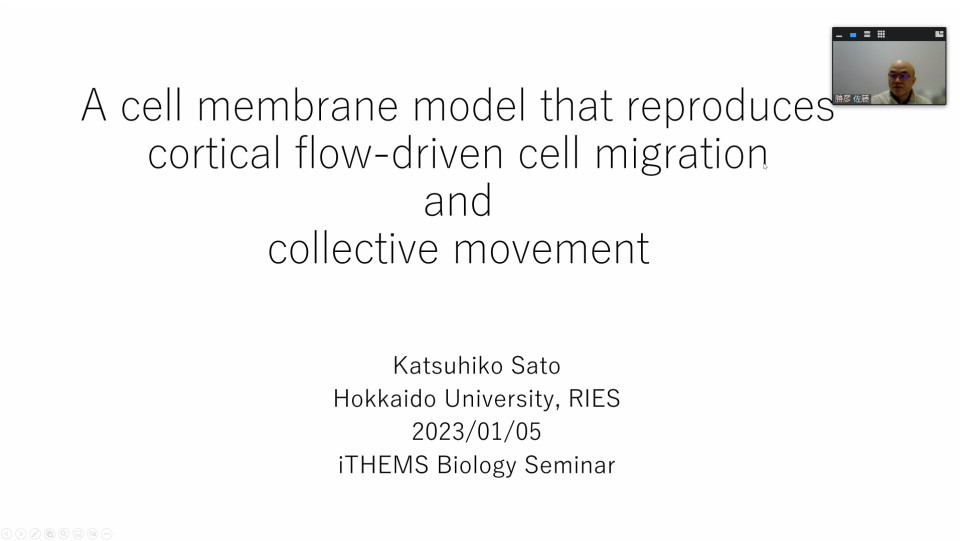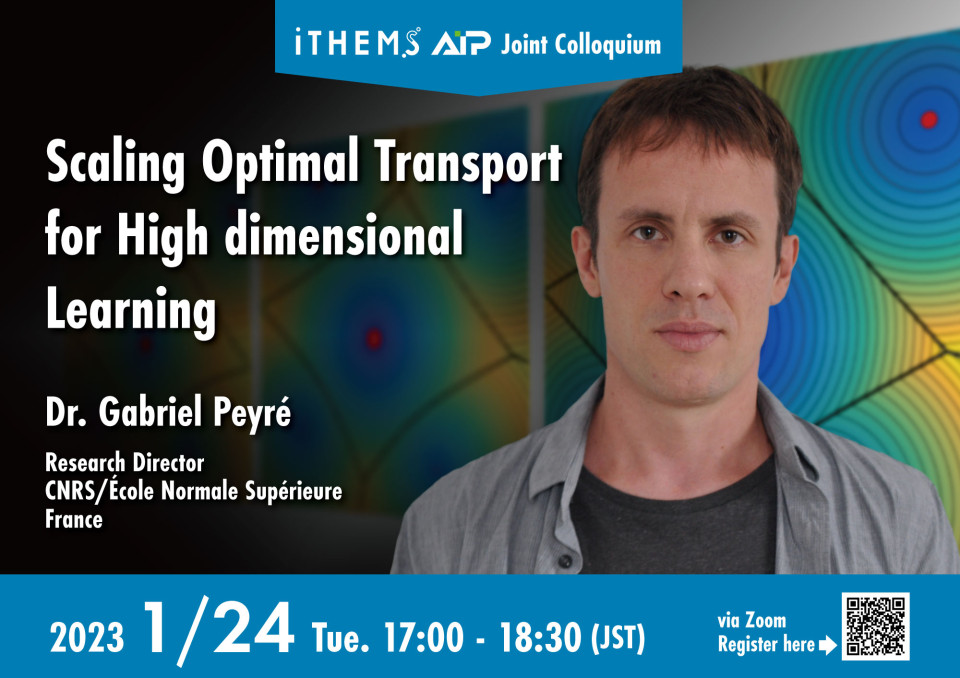Volume 233
Back to Newsletter List
Seminar Report
iTHEMS Biology Seminar by Dr. Yusuke Himeoka on November 17, 2022
2023-01-07
On last November, Dr. Yusuke Himeoka at the University of Tokyo told us about a mysterious phenomena of bacterial cells, called "dormancy". The title of his talk was "Emergence of growth and dormancy from a kinetic model of the Escherichia coli central carbon metabolism". Starting from a network model of metabolism, he theoretically discussed how dormancy emerges at bacterial cells. During and after the talk, there were lively discussions. Thank you so much, Himeoka-san!
Reported by Gen Kurosawa
Emergence of growth and dormancy from a kinetic model of the Escherichia coli central carbon metabolism
November 17 (Thu) 18:00 - 19:00, 2022
Seminar Report
iTHEMS Biology Seminar by Dr. Katsuhiko Sato on January 5, 2023
2023-01-06
In iTHEMS biology seminar on January 5, Katsuhiko Sato (Hokkaido University) talked about a theoretical model of cell migration. First, he gave us the overview about cell migration. The dominant forces for the cell migrations are believed to the hydrostatic pressure in the cell, the contraction force by actomyosins and the frictions. Next, he constructed a mechanical model of the cell migration in an elegant manner. In this mechanical model, the cell migration dynamics is described by the balance between the energy and the dissipation. The dissipation describes the frictions. The energy includes the hydrostatic pressure, the contraction force, bending energy and the surface tension. Then, he introduced the cell polarization into the surface tension. By using this mechanical model, he demonstrated the unidirectional movement and the rotation of the cell cluster. We enjoyed the discussion with Sato-san on the detail of the modeling and its result. Thank you very much for a great talk, Sato-san!
Reported by Hiroshi Yokota
A cell membrane model that reproduces cortical flow-driven cell migration and collective movement
January 5 (Thu) 16:00 - 17:00, 2023
Upcoming Events
Seminar
iTHEMS Theoretical Physics Seminar
Tetra-neutron system studied by RI-beam experiments
January 17 (Tue) 13:30 - 15:00, 2023
Susumu Shimoura (Research Scientist, Spin isospin Laboratory, RIKEN Cluster for Pioneering Research (CPR))
Multi-neutron systems have attracted a long-standing attention in nuclear physics. In several decades, experimental attempts have been made with a particular focus on the tetra-neutron system. Among them, the two different experiments, the double-charge exchange reaction on 4He and the alpha-particle knockout reaction from the 8He, show a sharp peak just above the threshold in the four-neutron spectra, which could be a signature of a "resonant state", separate from a broad bump structure at higher excitation energy regions. Both the experiments have been realized by using the 8He beam above 150 A MeV at the RIKEN RI Beam Factory.
Details of the two experiments including basic idea, experimental techniques, and analysis are presented as well as a historical review of previous experimental attempts. Emphasis is made for the experimental conditions for populating a kinematically isolated tetra-neutron system with very small momentum transfer. The spectral shape is discussed by means of reaction processes and correlations in the final tetra-neutron system with several recent theoretical studies.
Venue: Common Room #246-248, 2F Main Research Building, RIKEN / via Zoom
Event Official Language: English
Seminar
iTHEMS Biology Seminar
Mathematical models inspired by the Lenski experiment
January 19 (Thu) 10:00 - 11:00, 2023
Adrian Gonzalez-Casanova (Neyman Visiting Assistant Professor, University of California, Berkeley, USA / Associate Professor, National Autonomous University of Mexico, Mexico)
We will discuss the basic models of mathematical population genetics and see how to apply them to the study of the Lenski experiment. Furthermore, we will describe novel models that are capable of providing a parsimonious explanation of the deceleration of the relative fitness and can be used to attack questions such as, is it advantageous to be efficient? If time permits, we will also discuss examples of mathematical modelling beyond the Lenski experiment, including the study of populations of bacteria carrying plasmids.
Venue: via Zoom
Event Official Language: English
Seminar
ABBL-iTHEMS Joint Astro Seminar
Understanding kilonova spectra and identification of r-process elements
January 20 (Fri) 14:00 - 15:00, 2023
Nanae Domoto (Ph.D. Student, Department of Astronomy, Graduate School of Science, Tohoku University)
Binary neutron star (NS) merger is a promising site for the rapid neutron capture nucleosynthesis (r-process). The radioactive decay of newly synthesized elements powers electromagnetic radiation, as called kilonova. The detection of gravitational wave from a NS merger GW170817 and the observation of the associated kilonova AT2017gfo have provided with us the evidence that r-process happens in the NS merger. However, the abundance pattern synthesized in this event, which is important to understand the origin of the r-process elements, is not yet clear. In this talk, I will first introduce an overview and current understanding of kilonova. Then, I will discuss our recent findings of elemental features in photospheric spectra of kilonova toward identification of elements.
Venue: via Zoom
Event Official Language: English
Seminar
iTHEMS Math Seminar
Math and Physics of Seiberg-Witten theory
January 20 (Fri) 16:00 - 18:10, 2023
Nobuo Iida (JSPS Research Fellow PD, School of Science, Tokyo Institute of Technology)
Math and physics have developed through interactions with each other.
For example, classical mechanics and calculous were born together.
Einstein's theory of gravitation is written in the language of pseudo-Riemann geometry.
Since the late 20th century, physicists centering on Edward Witten have revolutionized modern geometry.
Seiberg-Witten theory is one of such breakthroughs, for both mathematicians and physicists.
In physics it is regarded as a theory describing strong coupling (i.e. low energy) behavior of some supersymmetric gauge theories. It showes confinement (by a mechanism similar to superconductivity) and electric magnetic duality.
Even though this story has not been mathematically justified yet, it is regarded as an important trigger of developments in understanding non perturbative aspects of quantum field theory and string theory, and stimulates broad fields of physics and math.
In math, Seiberg-Witten theory is regarded as a fundamental tool to study 3 and 4-dimensional geometry.
This is based on a PDE called Seiberg-Witten equation, which originates from the "electric magnetic dual description" of monopoles, but people can use it as a tool to study geometry without knowing such a physical origin.
In this talk, developments of Seiberg-Witten theory from both viewpoints will be reviewed and if the time permits, works in math by the speaker and collaborators will be discussed.
The speaker thinks it is unusual for a mathematician to talk about something that has not been mathematically justified yet, but hopes this talk will lead to new interactions between math and physics.
Venue: Hybrid Format (Common Room 246-248 and Zoom)
Event Official Language: English
Seminar
Information Theory Seminar
Physics-informed deep learning approach for modeling crustal deformation
January 23 (Mon) 10:30 - 11:30, 2023
Naonori Ueda (Deputy Director, RIKEN Center for Advanced Intelligence Project (AIP))
The movement and deformation of the Earth’s crust and upper mantle provide critical insights into the evolution of earthquake processes and future earthquake potentials. Crustal deformation can be modeled by dislocation models that represent earthquake faults in the crust as defects in a continuum medium. In this study, we propose a physics-informed deep learning approach to model crustal deformation due to earthquakes. Neural networks can represent continuous displacement fields in arbitrary geometrical structures and mechanical properties of rocks by incorporating governing equations and boundary conditions into a loss function. The polar coordinate system is introduced to accurately model the displacement discontinuity on a fault as a boundary condition. We illustrate the validity and usefulness of this approach through example problems with strike-slip faults. This approach has a potential advantage over conventional approaches in that it could be straightforwardly extended to high dimensional, anelastic, nonlinear, and inverse problems.
Reference
- Tomohisa Okazaki, Takeo Ito, Kazuro Hirahara & Naonori Ueda, Physics-informed deep learning approach for modeling crustal deformation, Nature Communications, vol. 13, Article number: 7092 (2022), doi: 10.1038/s41467-022-34922-1
Venue: via Zoom
Event Official Language: English
Lecture
Introduction to the Quantum Theory of Gravity via Asymptotic Safety
January 24 (Tue) - 26 (Thu) 2023
Ohta Nobuyoshi (Visiting Professor, Department of Physics, National Central University, Taiwan)
We give an introduction to the formulation towards the quantum theory of gravity using the functional (or exact) renormalization group, the so-called asymptotic safety. First we briefly explain the necessity of quantization of gravity and why the Einstein gravity is not sufficient for this purpose. Second, we introduce the functional renormalization group equation and explain what is the asymptotic safety program to achieve the quantum theory of gravity. This includes the notion of relevant, irrelevant and marginal operators, and it is important that there are finite number of relevant operators to make any prediction of quantum effects. This gives a nonperturbatively renormalizable theory of gravity. We then discuss various examples how the program may be applied to various theories, and summarize the current status of this approach.
(Tentative schedule)
[Day 1: Jan. 24, 2023]
Free discussion: 9:30 - 10:30
Lecture 1: 10:30 - 12:00
Lunch: 12:00 - 13:30
Lecture 2: 13:30 - 15:00
Break: 15:00 - 15:30
Lecture 3: 15:30 - 17:00
[Day 2: Jan. 25, 2023]
Free discussion: 9:30 - 10:30
Lecture 4: 10:30 - 12:00
Lunch: 12:00 - 13:30
Lecture 5: 13:30 - 15:00
Break: 15:00 - 15:30
Lecture 6: 15:30 - 17:00
[Day 3: Jan. 26, 2023]
Q&A + discussion: 9:30 - 15:00
Venue: #535-537, 5F, Main Research Building, RIKEN Wako Campus
Event Official Language: English
Colloquium
iTHEMS Colloquium
Scaling Optimal Transport for High dimensional Learning
January 24 (Tue) 17:00 - 18:30, 2023
Gabriel Peyré (Research Director, CNRS/École Normale Supérieure, France)
iTHEMS-AIP Joint Colloquium
Optimal transport (OT) has recently gained a lot of interest in machine learning. It is a natural tool to compare in a geometrically faithful way probability distributions. It finds applications in both supervised learning (using geometric loss functions) and unsupervised learning (to perform generative model fitting). OT is however plagued by the curse of dimensionality, since it might require a number of samples which grows exponentially with the dimension. In this talk, I will explain how to leverage entropic regularization methods to define computationally efficient loss functions, approximating OT with a better sample complexity. More information and references can be found on the website of our book "Computational Optimal Transport" (see related link below).
Venue: via Zoom
Event Official Language: English
Paper of the Week
Week 3, January 2023
2023-01-12
Title: Numerical studies on the finite-temperature CP restoration in 4D SU(N) gauge theory at $θ=π$
Author: Akira Matsumoto, Kohta Hatakeyama, Mitsuaki Hirasawa, Masazumi Honda, Jun Nishimura, Atis Yosprakob
arXiv: http://arxiv.org/abs/2301.03879v1
Title: Spin conductivity spectrum and spin superfluidity in a binary Bose mixture
Author: Yuta Sekino, Hiroyuki Tajima, Shun Uchino
arXiv: http://arxiv.org/abs/2301.03031v1
Title: Apolipoprotein A1 and high-density lipoprotein limit low-density lipoprotein transcytosis by binding scavenger receptor B1
Author: Karen Fung, Tse Wing Winnie Ho, Zizhen Xu, Dante Neculai, Catherine A. A. Beauchemin, Warren L. Lee, Gregory D. Fairn
doi: https://doi.org/10.1101/2022.08.08.503162
Title: Utility of Human In Vitro Data in Risk Assessments of Influenza A Virus Using the Ferret Model
Author: Hannah M. Creager, Troy J. Kieran, Hui Zeng, Xiangjie Sun, Joanna A. Pulit-Penaloza, Katie E. Holmes, Anders F. Johnson, Terrence M. Tumpey, Taronna R. Maines, Catherine A. A. Beauchemin
Journal Reference: Journal of Virology
doi: https://doi.org/10.1128/jvi.01536-22
If you would like to cancel your subscription or change your email address,
please let us know via our contact form.
Copyright © iTHEMS, RIKEN. All rights reserved.



